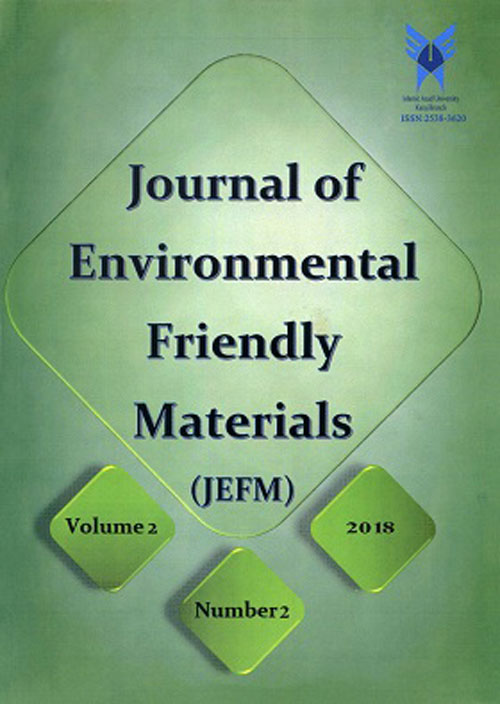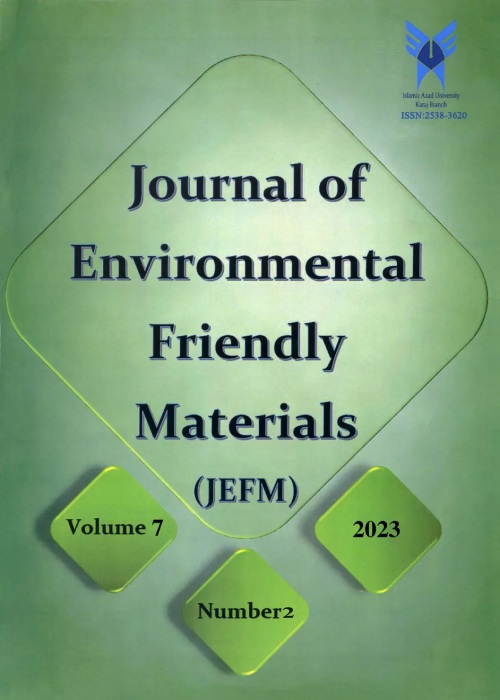فهرست مطالب

Journal of Environmental Friendly Materials
Volume:2 Issue: 1, Winter-Spring 2018
- تاریخ انتشار: 1396/10/11
- تعداد عناوین: 8
-
Pages 1-6In the thermal spray process, particulate materials can be melted by plasma atmosphere due to its high local temperature from 8700 ◦C to 15,000 ◦C. Therefore, the material powders turn into droplets after being melted by injection into the hot flame. Molten droplets are accelerated toward a substrate and form the splats which quickly solidify; finally, the film is formed by pile-up splats. Splat morphology and post treatment can determine the microstructure, mechanical and physical properties of the coating. In this study, BaTiO3 films were deposited onto a mirror polished stainless steel substrates kept at room temperature and 500 ◦C. At the elevated temperatures, the desorbtion of adsorbates and condensate at the substrate surface are the most important factor which change the morphology of the splats, from irregular- splash morphology to disk-like shape. Splat morphology can determine sprayed film microstructure and effect on the coating properties. The morphology of individual splats and the post treated films were studied using scanning electron microscopy. Results indicated that the porosity in the film produced at room temperature was higher than that in the film deposited on the heated substrates. Also, results show post heat treatment can improve physical and mechanical properties of the sprayed coating.Keywords: Splat Morphology, heat treatment, BaTiO3, Air Plasma Spray, Dielectric Properties
-
Pages 7-12In current research, the Friction Stir Welding (FSW) technique was used to create a metallurgical joint between Al 6061 plates and Cu meat core. The plates were welded using single pass weld with the rotational speed of 1000 rpm and arc travel speed of 30 mm/ min using different tool pin profiles of cylinder, triangle, and hexagonal. After the rolling process and reaching to 1.7 mm of thickness, to evaluate whether there was no separation in layer plates, the radiography test was applied. For more investigation of the created metallurgical bond, optical microscopy (OM) and scanning electron microscopy (SEM) were used. Studies on the welded samples showed a perfect metallurgical bonding. The bonding thickness between Al plates and the Cu meat sample in the samples with pin profiles of triangle, cylinder and hexagonal shape were estimated to be 30, 39 and 45 µm, respectively. Moreover, in comparison to the FSW samples with triangle and cylinder pin profile, the microhardness and ultimate tensile stress were higher in the FSW samples using hexagonal pin profile. It was owing to the fact that hexagonal pin profile had a larger contact area compared with the other two pins. Therefore, the mechanical work using hexagonal pin was more, resulting in an increase in the hardness and tensile stress. In addition, material flow in the bonding zone increased and contributed to an increase in the width of the joint areaKeywords: Friction stir welding, Al 6061, mechanical properties
-
Pages 13-17In this study, the simultaneous effects of Zn addition and critical gate velocity on hot tearing susceptibility of A356 and A206 aluminum alloys were investigated. In order to investigate these two parameters, ingate velocities of 0.5, 0.75, 1, 1.5 m/s were taken into account. After performing the casting process, the samples were investigated by visual examination, and scanning electron microscopy. In order to quantitative evaluation of results, ProCast software were used. The results of the present study showed that increasing the Zn content for alloy A356, had no effect on hot tearing susceptibility of this alloy, while with increasing the Zn content from 0.01 to 2.8 wt%, the number and severity of the tears were increased.Keywords: Al Alloys, Hot Tear, Zinc, Critical Ingate Velocity, simulation
-
Pages 19-22In this investigation the microstructure and mechanical properties of Al-Zn (Al 7075) MIG weld metal were studied in respect to T5 post weld heat treatment variables. Samples were cut from butt weld which were produced by automatic MIG welding with the same heat treatment in different times (10 to 480 minute) and temperatures (85 to 225). The mechanical test results showed that the optimum mechanical properties (as: tensile and yield strength, impact energy and hardness) gained in 155 and 120 minute. XRD, Optical metallographic and EDX point analysis results of the sample with best mechanical properties (155 ̊C - 120min) showed that the microstructure consists of fine grain above 15 µm diameter with 15% precipitate, in addition the precipitates were distributed at the grains and grains boundary, at the grains boundary Al2Mg3Zn3 and in the grains CuAl2 were precipitatedKeywords: PWHT, Al-Zn, Weld Metal
-
Pages 23-25The aim of this study is comparing preparation methods of hydroxyapatite-bioglass composite nanopowders which can be prepared in different routes based on sol-gel method for orthopaedic/dental applications. Nanostructure materials present a unique and incomparable character for orthopedic and dental implant. Hydroxyapatite-bioglass composite nanopowders with the same contents of bioglass (20%) as reinforcement have been prepared by using a sol-gel method in four routes: mixing sols before aging time, mixing bioglass sol with hydroxyapatite gel after gelation, mixing calcinated bioglass nanopowder with hydroxyapatite sol, and mixing two calcinated powders by mechanical alloying. Bioactive glass of the type CaO-P2O5-SiO2 was obtained by the source of tetraethylorthosilicate, triethylphosphate and calcium nitrate tetrahydrate. On the other hand, phosphoric pentoxide and also calcium nitrate tetrahydrate were applied as the source of hydroxyapatite. Calcination temperature was 600°C for both compositions. XRD, SEM, and EDS techniques were used to investigate the microstructure and morphology of the nanopowders. Results indicated that because of different mixing time of hydroxyapatite with bioglass in either sol form, gel form or calcinated powder, the morphology, crystallinity, crystallite size and composition of products were varied. bioglass remained amorphous in all routes of synthesis. Because of presence of amorphous bioglass, In situ synthesis of hydroxyapatite-bioglass composite nanopowders resulted in decreasing the crystallinity and the crystallite size of hydroxyapatite. Furthermore, by mixing two nanopowders after calcination, hydroxyapatite crystallinity was maximum and also by using this route proportion of two parts can be easily controlled.Keywords: Hydroxyapatite, bioglass, Composite, Nanopowder, Sol-gel
-
Pages 27-32A vibrational base nondestructive method is proposed to estimate the modulus of rupture (MOR) in medium density fiberboard (MDF) whole plate. A premium grade MDF panel was tested in longitudinal and flexural vibration approaches in panel longitudinal axis and its perpendicular direction. Then, the panel was cut into smaller and smaller plates and prismatic beams while the vibrational properties were collected in each step. Finally, the static bending method was used to evaluate the static MOE and MOR in final prismatic MDF beams. The dynamic and static MOEs were compared together and used along with the logarithmic decrement to correlate with static MOR of the beams. A multi-regression model of lumber MOR prediction was fitted also to MDF plate, considering a correction coefficient in terms of vibration plane (longitudinal or flexural). The modified multi-regression model for the MDF panel was successful to estimate MOR, comparable to those of obtained in static bending standard methodologyKeywords: Flexural, Longitudinal, MDF, Nondestructive, Rupture, Vibration
-
Pages 33-39Soft soil is one of the major challenges in engineering projects. Improving soil’s engineering properties is called soil stabilization. This paper focuses on soil stabilization materials and methods thereby soils and related materials and structures are made stronger and more durable. Soil stabilization involves the using of stabilizing agents, binder materials, in soft soils to improve its geotechnical properties such as bearing capacity, compressibility, shear strength, permeability and durability. Using of stabilized soils in place with natural aggregates and structure of soil has great environmental and economic advantages. Investigation for selection the best soil stabilizers to overcome geotechnical problems occur by the weak soils is one of the main concerns to attain the required soil engineering parameters by considering the cost, efficiency and the effect to the environment. This paper reviews the application of different materials and additives used in soil improvement in geotechnical projects in Iran and present their effects on soil engineering parameters.Keywords: Soil Stabilization, Environmental Friendly, Stabilizer Materials
-
Microstructural Investigations and Fracture Analysis of a Multi-Layer Al Panel of a Crashed AircraftPages 41-47In this paper, the failure analysis was performed on a crashed airplane trunk sample. Received sample was composed of five different layers; Al 2024 as outer layer, a nearly pure Al clad, an anodized layer, an isolating material and the alloy 413 as interior layer. Macro and micro-cracks in the sample were mostly initiated from the areas close to or around the rivets. These cracks initiated in anodized layer, got through the cladding and entered into the outer Al 2024. Few corrosion sites similar to crevice were also observed behind the rivets and between isolating and cladding layers. It was found that the crevice corrosion and fatigue were responsible to form micro-cracks at these sites. Microstructural observations of Al 2024 layer showed that the micro-cracks were mostly initiated form inside out then they progressed through the interfaces of second phase particles and the matrix. It was found that larger particles were in favor of crack propagation along their interfaces. Second phase large particles are attributed to over-aging of trunk sample which was subjected to excessive heat from the engines.Keywords: Aluminum 2024, Aging, Fractography, Crevice Corrosion, Fatigue, Crack Propagation


